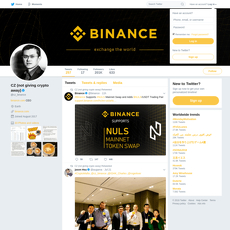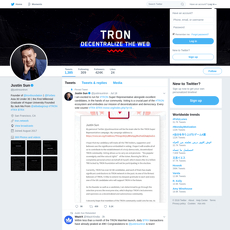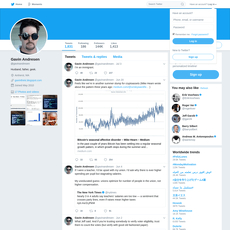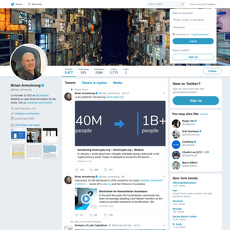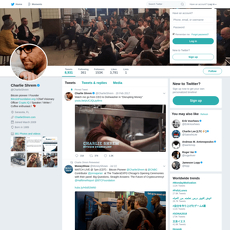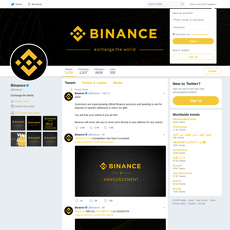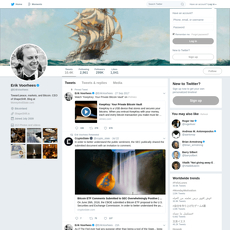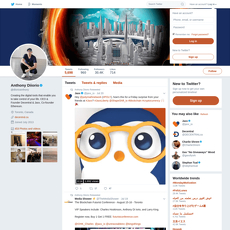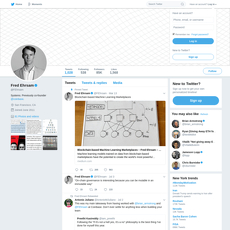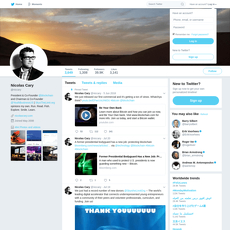Vitalik Buterin Review
Vitalik Buterin
twitter.com
Vitalik Buterin Twitter Review Guide: Everything You Need to Know about him + FAQ
Ever scroll past a “Vitalik said…” tweet and wonder if it’s real, important, or just another crypto bait post? You’re not alone—his feed attracts sharp insights, but it also attracts fakes, misquotes, and noise. Let’s fix that.
What’s actually worth your attention on Vitalik’s Twitter, and what’s just noise?
If you’re following https://twitter.com/vitalikbuterin, here’s the reality: it’s easy to get lost. Impersonators ride big news cycles, headlines twist technical threads into drama, and screenshots go viral without context. On top of that, a lot of what he posts assumes you know the basics of Ethereum research, which can make a simple thread feel like a wall of jargon.
Real-world example: in September 2023, Vitalik’s account on X (Twitter) was compromised and a phishing link was posted. Users who clicked lost funds to a wallet drainer within hours—on-chain sleuths like ZachXBT tracked losses in the hundreds of thousands of dollars. Events like that fuel a constant stream of fake “Vitalik” accounts and copycat scams that still pop up around major Ethereum milestones.
Zooming out, this fits a bigger trend: scams remain one of the largest categories of crypto-related crime, according to ongoing research from industry monitors like Chainalysis. Social platforms are a favorite hunting ground because they’re fast and emotional—perfect for luring people with urgency, giveaways, or fake airdrops.
- Fake accounts: lookalike handles, one-letter swaps, or newly created profiles using his photo.
- Misquotes: screenshots pulled out of context, often missing the replies where he clarifies.
- Clickbait: “Vitalik kills X,” “Vitalik pivots to Y,” when the original thread is a nuanced research idea or a thought experiment.
- Jargon overload: terms like MEV, rollups, EIPs, danksharding—easy to misread if you don’t check the source links he shares.
I’ll show you how to make his feed actually useful
Here’s my promise: I’ll walk you through how to read @vitalikbuterin like a pro—what he posts, how often, and what it really means for Ethereum. You’ll learn how to verify it’s truly his account, spot red flags instantly, and turn his tweets into practical context instead of confusion. I’ll also include a clean FAQ that cuts through the most searched questions about Vitalik without gossip or guesswork.
Why you should trust this guide
I spend my days reviewing crypto platforms and tools, tracking where the real signal is, and filtering out what wastes your time (or risks your wallet). I don’t run promos, I don’t sell picks, and I don’t care about hype. I care about clarity, original sources, and keeping people safe while they learn.
Quick notes before we start
- This isn’t financial advice. Think of it as a reading guide for one of crypto’s most influential voices.
- Stick to original sources. If a screenshot looks spicy, click through to the real thread. Vitalik often clarifies in replies.
- Beware impersonators. Confirm the handle (@vitalikbuterin), check for the verified badge, and cross-check with links on his personal site or Ethereum.org when in doubt.
- Respect privacy. Focus on ideas and public work; ignore rumor bait.
- Assume urgency = scam. Giveaways, “send ETH to get double,” “limited-time airdrops” using his name—report and move on.
“If a post sounds like a free money machine, it’s not Vitalik. If it sounds like a careful thought on scaling, security, or cryptography—it probably is.”
Ready to get the real value from his tweets without the traps? In the next part, I’ll lay out who Vitalik is today (no fluff), why his posts can move markets, and how to read them with the right context so you don’t miss the signal. Curious why a single thread from him can shift sentiment across Ethereum? Let’s answer that next.
Vitalik 101: who he is and why his tweets move markets
When Vitalik Buterin posts, founders, researchers, and traders pay attention. Not because he’s handing out “alpha,” but because he signals where Ethereum is heading next—what’s urgent, what’s risky, and what’s possible. One clear sentence from him can reset a narrative or kick off months of R&D.
“The Ethereum ecosystem is likely to be all-in on rollups as a scaling strategy for the near and mid-term future.”
— Vitalik Buterin, A rollup-centric Ethereum roadmap
Short bio in plain English
Vitalik is the co-founder of Ethereum, a writer, and a researcher who has been shipping ideas in crypto since his teenage years. Born in Russia and raised in Canada, he started by writing for and co-founding Bitcoin Magazine, then co-created Ethereum at 19. He’s best known for his long-form essays (vitalik.ca) and for putting tough problems on the table in a way both engineers and regular users can understand.
What he actually does today
- Roadmap steward, not CEO: He doesn’t run a company. He points to trade-offs, shares priorities, and sets expectations for where Ethereum is going.
- Research and standards: He writes and reviews ideas that become EIPs (Ethereum Improvement Proposals), like EIP‑4844 (proto-danksharding) for cheaper L2s and EIP‑4337 (account abstraction) for smarter wallets.
- Public goods and funding: He champions mechanisms like quadratic funding and supports ecosystem grants to boost the “boring but vital” infrastructure.
- Security and ethics guardrails: He pushes for designs that limit MEV extraction, improve decentralization of staking, and protect users from hidden risks.
- Privacy-preserving UX: He explores practical privacy, from stealth addresses to “privacy pools,” balancing civil liberties with compliance realities.
What he tends to care about
- Scalability without breaking decentralization: Rollups, data availability, sharding, and the path to cheaper transactions for everyone. See: Endgame and the rollup roadmap.
- Protocol security: Healthy staking, client diversity, censorship resistance, and mechanisms that reduce systemic risk.
- MEV and fair markets: Builder-proposer separation, better auction designs, and norms that protect users.
- Privacy that works in the real world: Tools that let normal people transact without broadcasting their lives on-chain.
- Public goods and legitimacy: Funding what the market underpays and keeping the ecosystem credible. See: The Most Important Scarce Resource is Legitimacy.
Why his tweets move markets
Influence in crypto isn’t only about followers—it’s about being the person whose ideas end up in the protocol. Vitalik’s tweets often act as a leading indicator of what researchers, core devs, and builders will focus on next. That ripple quickly reaches exchanges, wallets, L2s, and—yes—traders.
- Signals on scaling: When he underscored the importance of EIP‑4844, the market quickly priced in a world of cheaper L2 transactions. After the Dencun upgrade shipped in March 2024, fees on major L2s dropped dramatically—exactly the kind of user impact his posts primed people to expect.
- Wallet and UX narratives: Support for account abstraction (EIP‑4337) re-energized the “smart accounts” movement. Wallet teams accelerated passkey logins, session keys, and gas sponsorship—changes he’s been advocating for years.
- Risk framing: Short threads warning about staking centralization or MEV patterns can cool down risky behavior and shift how services position themselves, which in turn affects liquidity flows.
There’s also a broader effect: research has shown that social media signals influence crypto sentiment, volume, and volatility. Academic and working papers (including work published in Finance Research Letters and by independent researchers on SSRN) find that posts from high-credibility accounts can precede abnormal returns and trading spikes. It’s not magic—it’s coordination. When the person closest to the roadmap highlights a theme, builders and capital both move.
Underneath the tech, there’s a human element too. Vitalik’s writing often reads like a reminder to focus on what matters: user safety, open access, and long-term health. As he’s said in many ways, hype fades; credible progress compounds. That’s why his tweets feel different—less noise, more North Star.
Curious how that shows up on your feed—how often he posts, what formats he uses, and how to read a thread without missing the “meat” in the links? Keep going; that’s exactly what’s next.
What to expect from @vitalikbuterin on Twitter
If you’re scrolling for signal, good news: Vitalik’s timeline usually is. His posts aren’t promo blasts or trading calls—they’re a running log of what matters for Ethereum and the tech around it. Here’s how I read his feed so nothing important slips by.
Frequency, tone, and format
Expect uneven bursts. He’ll go quiet for a bit, then post a run of thoughts when a research idea lands, an upgrade ships, or a new essay drops. The feel is calm and exploratory, not hypey.
- Bursts around milestones: protocol upgrades, security debates, or a fresh blog post on vitalik.ca.
- Mostly text, sometimes threads: short takes for context, threads for outlines, links for depth.
- Rarely promotional: you won’t see “buy this token” or affiliate links. If you do, it’s not him.
“A mechanism is credibly neutral if people can be confident that the mechanism is not biased toward any particular people or outcomes.”
— Vitalik Buterin, Credible Neutrality as a Guiding Principle
That lens—credible neutrality—is why his posts tend to champion long-term resilience over quick wins. It’s also why you won’t find price talk.
Common topics you’ll see
Vitalik’s Twitter is the front door; the full room is often his blog or a research doc. The topics repeat by design: they’re the foundation stones.
- Rollups and L2s: pathways to scale Ethereum without breaking decentralization. Example: his still-relevant explainer An Incomplete Guide to Rollups.
- MEV and protocol design: how to reduce extraction and keep block production fair.
- Staking and security: trade-offs in validator economics, censorship resistance, and finality.
- Privacy tech: stealth addresses, zero-knowledge tools, and designs that protect users without enabling abuse.
- Social recovery and account abstraction: practical wallet safety and UX improvements; see Why we need wide adoption of social recovery wallets.
- Governance trade-offs: credible neutrality, public goods, and retroactive funding.
- AI intersections: where cryptography, coordination, and machine learning meet.
When a theme reappears, it’s usually because a concrete piece just shipped (like a new EIP) or a known weakness is being worked on. If you’re tracking upgrades, his posts are the “why,” not just the “what.”
How to read threads vs. research links
Threads are your map; links are the terrain. I treat them differently:
- Threads = high-level take: a quick outline of a concept, a nudge to a debate, or an update on a design direction.
- Links = the real argument: the math, the incentives, the edge cases—often on his blog or in a paper he co-authored.
Quick way to not miss the meat:
- Open the thread, scan the first and last tweet, then tap the link if there is one. For example, a short tweet about “endgame” design points to the full essay: Endgame.
- Check his own replies under the thread—he often tucks clarifications there that never make headlines.
- Search his handle with a keyword: from:vitalikbuterin rollup, from:vitalikbuterin privacy, from:vitalikbuterin EIP-4844 to assemble context quickly.
Why bother with links? Because they cut through misquotes. A well-known study from MIT (Science, 2018) found that false news spreads faster than true online—especially as screenshots get passed around. Source matters. Link: The spread of true and false news online.
What he avoids (and why that matters)
- No token picks, no price calls: if you see “Vitalik says buy X,” assume it’s fake.
- No giveaways or airdrops: real posts don’t ask you to connect a wallet or send ETH.
- No influencer vibes: he won’t chase engagement; he’ll post a 2,000-word essay instead of a viral thread.
This pattern is a huge tell. If a “Vitalik” tweet dangles rewards, urgency, or a “limited window,” it’s almost certainly an impostor.
Engagement patterns worth noting
Watch the replies. Vitalik often refines nuance there, especially when a take gets misunderstood.
- He answers real critique: you’ll see thoughtful back-and-forth with protocol researchers and client devs rather than hype accounts.
- One-liners that reset narratives: a short reply can reframe a debate on decentralization, governance, or security assumptions.
- Signals through retweets: when he amplifies EF research, EIPs, or talks by core contributors, it’s a soft “this matters.”
Emotionally, his feed feels like a lab notebook more than a podium. That’s the point. It rewards curiosity and patience. If you skim for hot takes, you’ll miss the parts that actually compound your understanding.
Quick mental checklist when a new Vitalik post lands:
- Is this a thread or a single post? If thread, read the whole thing.
- Is there a link? If yes, that’s the full context—open it.
- Any follow-up replies from him? Scan for clarifications.
- Does it ask for money or wallet connections? If yes, it’s not him.
Next question: how do you make sure you’re reading the real account—and not a sharp-looking fake or a doctored screenshot? I’ll show you a few fast checks and scam patterns that save a lot of pain, plus the exact red flags that trick most people in under three seconds.
Spot the real account, spot the value, skip the scams
If you want the good stuff from Vitalik without wading through junk (or getting phished), here’s how I keep my feed clean and my wallet safe. Quick, practical, and battle-tested.
“Trust the source, not the screenshot.”
Verify it’s really him
Impersonators are everywhere, and a blue check alone isn’t proof anymore. Do this every time before you engage or click:
- Check the exact handle: @vitalikbuterin. Watch for lookalikes like @vitalikbuterln (L instead of i), @vitalik_buterin_, or accented characters (buterín).
- Cross-check from a trusted page: Follow the link from his blog vitalik.ca or from ethereum.org. If the handle isn’t exactly the same, back out.
- Scan the account’s history: Long-standing thread patterns, replies with core Ethereum researchers, and years of archives are a strong signal. New accounts with huge promises = no.
- Look at the replies: If it’s actually him, you’ll often see high-signal names (Tim Beiko, Danny Ryan, Justin Drake, Dankrad Feist) engaging or being tagged.
- Open the link yourself: Never trust URL previews in screenshots. Click through from the authentic handle or type the domain manually.
Important: Even real accounts can be compromised. In September 2023, Vitalik’s Twitter was hacked and a phishing link was posted; victims lost hundreds of thousands in NFTs and tokens within hours (reported by multiple outlets, e.g., CoinDesk). That’s why you always confirm the domain and think before you sign.
Red flags and scam patterns
Most of the bad stuff rhymes. If you see these, stop.
- “Send ETH and get double” or any “limited-time multiply” scheme.
- “Claim now” airdrops that push you to connect a wallet and sign blind approvals (Permit2/Approval phishing). ScamSniffer tracked $295M+ lost to wallet-drainer phishing in 2023 alone, with hundreds of thousands of victims.
- Newly created accounts using Vitalik’s photo and bio, often with slightly altered handles and generic inspirational tweets.
- Deepfake videos/live streams pairing Vitalik with celebrity faces and QR codes to “participate.”
- Shortened or odd domains (punycode, misspellings, extra hyphens). Example: vιtalik.ca (Greek iota) or buterln.com (L instead of i). Copy the link into plain text to spot trick characters.
- Urgency + wallet signature: “Only 10 minutes left,” “gasless mint,” “whitelist guarantee” paired with a transaction prompt. If you’re rushed, you’re being played.
Pro move: When in doubt, reject the signature and inspect it in a safe tool later. No legit announcement requires you to rush a blind approval.
Avoid misquotes and out-of-context shares
Half the drama around Vitalik starts with a screenshot missing the full thread. Fix it with two clicks:
- Always click through to the original tweet or thread from @vitalikbuterin. If there’s no direct link, assume spin.
- Check the thread count and replies: He often clarifies in follow-ups or quote-replies. The bulk of nuance sits there.
- Look for a link out: When a tweet feels thin, it usually points to a blog post or paper with the full argument. Read that, not the hot take.
- Check the date and context: Old technical threads get recycled during news cycles. Make sure it’s current and not a relic from pre-merge or pre-EIP updates.
- Scan for Community Notes or comments from core researchers. If trusted names are correcting it, you’ve got your answer.
Quick reality check: news accounts love to cherry-pick one line that sounds spicier than the full thread. If a quote feels explosive, it’s almost always incomplete.
Building a clean Vitalik feed
You want signal, not noise. Here’s the setup that keeps my scroll sharp:
- Create a List with high-signal Ethereum voices so you see the conversation in context:
- @vitalikbuterin
- @TimBeiko (protocol updates)
- @dannyryan (consensus/PoS)
- @drakefjustin (research)
- @dankrad (research)
- @ethereum (EF announcements)
- Mute bait words that clutter your view: “giveaway,” “double your,” “airdrop,” “100x,” “send ETH,” “free mint.”
- Save first, read properly: Bookmark threads and pair them with the linked essays later. You’ll absorb more and avoid knee-jerk reactions to partial info.
- Use quote-tweet checks: If you see a viral quote of Vitalik, open the original and read two levels of replies for context before reacting.
Want the exact filters and alert setup I use so you catch the good stuff without getting pinged every five minutes? I’ll share the simple configuration next—plus the links I keep pinned so I can verify anything in seconds. Ready to make your feed work for you?
Tools, links, and smart ways to follow along
You don’t need to camp on X all day to catch the good stuff. Set up a simple system that pulls in real updates, cuts out noise, and gives you time to think. As I like to remind myself:
“Signal beats speed. Save first, read slow, decide later.”
Must-hit sources around his posts
Primary feed: twitter.com/vitalikbuterin
Tip: When he posts a short take, he often links to a longer piece. Always follow the link before forming an opinion.
His writings: vitalik.ca
Essays and research notes that expand on tweets. Save essays you care about and reread after a week; you’ll catch more nuance.
Ethereum Foundation blog: blog.ethereum.org
Official context for upgrades, research directions, and ecosystem priorities that often align with what he’s signaling.
EthResearch forum: ethresear.ch
Where many of the ideas he references get debated in-depth. If a tweet feels “thin,” there’s usually a thorough thread here.
Thread tools (use with caution): Thread Reader
Great for saving long threads, but always click through to the original tweet for verification and context.
Personal site (contact and links): buterin.com
Keep this bookmarked for official links and contact info.
Why set this up? Pew Research has shown news fatigue is real and growing—filters and “save to read” habits protect your attention while keeping you informed. If you’ve ever felt worn out scrolling, you’re not alone.
Alerts and filters that actually help
Turn on selective notifications: On his profile, tap the bell and choose All Tweets or Tweets and replies.
Personal rule: Pause alerts during deep work. Batch them to a couple windows a day.
Use smart keyword searches you can revisit:
Save these queries in X Search and check when you have time:
from:vitalikbuterin rollup OR L2 OR "data availability"
from:vitalikbuterin EIP OR (4844 OR danksharding)
from:vitalikbuterin MEV OR PBS OR "builder proposer separation"
from:vitalikbuterin privacy OR zk OR ("zero-knowledge")
How I use this: I save each search once, then check “Latest” once a day. It’s a clean stream of exactly what I care about.
Mute the junk: Reduce false alarms by muting words like giveaway, airdrop, free, double your, and random ticker spam ($PEPE, $BONK, etc.). Your focus will thank you.
Batch-reading workflow: Use Readwise Reader or your favorite read-it-later app. Save tweets and linked essays together so you process the full argument, not just the one-liner.
Real example: when he posted about proto-danksharding (EIP-4844), the tweet was short, but the linked resources and follow-up discussions on the EF blog and EthResearch carried the depth. A saved search for from:vitalikbuterin (4844 OR danksharding) plus a read-it-later app keeps that thread organized for you.
Complementary sources (for context and depth)
EF research updates: blog.ethereum.org (check Research and Protocol categories)
EIPs (specs and status): eips.ethereum.org and the repo github.com/ethereum/EIPs
EthResearch forum: ethresear.ch (often the missing context behind a tweet)
MEV and PBS research: writings.flashbots.net
Rollup reality checks: l2beat.com (security models, TVL, upgrade keys—great for sanity-checking hot takes)
All Core Devs calls (meeting notes): github.com/ethereum/pm (what’s actually shipping)
Talks and keynotes: EF Devcon YouTube and Ethereum Foundation YouTube
High-signal listening: Zero Knowledge Podcast and The Daily Gwei for steady, technical context without the fluff.
You’ve got the setup to track the signal without frying your attention. Now, what about the questions that keep popping up—his health, IQ rumors, or the safest way to contact him without getting scammed? I’m answering those next, straight and sourced. Ready?
The big Vitalik FAQ (quick, sourced, and no fluff)
What illness does Vitalik Buterin have?
He doesn’t have an “illness.” Vitalik has publicly shared that he’s on the autism spectrum. That’s a neurotype, not a disease. He’s described how it shapes his focus and communication style, and it tracks with what you see in his writing: precise, systems-first, low on fluff.
For context (not diagnosis), research suggests many autistic people show strong attention to detail and “systemizing” strengths—useful traits for protocol design and cryptography. See the Cambridge Autism Research Centre’s overview of systemizing for a friendly intro:
autismresearchcentre.com.
If you’re seeing rumors beyond that, treat them as rumors. He’s been open about this one point himself (including on public podcasts and Twitter), and that’s the appropriate boundary.
What is the IQ of Vitalik Buterin?
You’ll see viral screenshots claiming cartoonish numbers like “257.” There’s no credible source for any specific IQ score. He’s never published one, and IQ is test-specific anyway.
Also, IQ ≠ protocol vision. The American Psychological Association notes IQ tests measure specific cognitive abilities, not creativity, wisdom, or judgment—things that actually matter in building Ethereum. If you’re curious, the APA’s primer is a good reality check:
apa.org/topics/intelligence.
How to get in touch with Vitalik Buterin?
Short answer: use public, verifiable channels only. He’s a high-profile target for impersonation.
- Email: Use the contact listed on his personal site (buterin.com). If it’s not there, don’t guess—impostors love email lookalikes.
- Research and proposals: Most Ethereum ideas belong in public forums, not DMs. Use:
- EIPs on GitHub: github.com/ethereum/EIPs
- Ethereum Magicians: ethereum-magicians.org
- Ethereum Foundation resources: ethereum.org
- Twitter: He rarely handles “business” by DM. If someone messages you “from Vitalik” asking for funds or private keys, it’s a scam. The real account is
@VitalikButerin.
Pro tip: If your message is legit research, keep it short, cited, and public. A descriptive subject line, a one-sentence ask, and a link to a public repo or doc gets read far more often than a wall of text.
What ethnicity is Vitalik Buterin?
He’s Russian-Canadian. Born in Kolomna, Russia; later moved to Canada with his family. If you want a basic bio snapshot, the public entry is here:
Wikipedia: Vitalik Buterin.
Other common questions I get
- Philanthropy: He’s publicly directed large crypto donations to pandemic response and longevity research, and he’s supported public goods funding (think: Gitcoin’s quadratic funding). A well-known example was the 2021 on-chain donation to India’s COVID relief. You can verify major transfers on-chain (see his known address below).
- Where to read his essays: His long-form thinking lives on his blog:
vitalik.ca. If a tweet feels thin, the full argument is usually there. - Talks and appearances: Look for Devcon archives and Ethereum Foundation channels. Start with
devcon.org and the EF’s YouTube presence for recorded keynotes and panels. - Net worth guesses: Treat them as entertainment. Markets move, and no list of wallets is complete. One well-known ENS is vitalik.eth (resolving to
0xAB58…EC9b), which you can inspect on Etherscan. Still, that’s not the whole picture, and it changes. - Does he give trading tips? No. If you see “airdrop,” “double your ETH,” or price calls “from Vitalik,” assume scam first, then verify the source.
Bottom line: Stick to what he publishes himself (Twitter, blog, conference talks, on-chain activity). Everything else needs receipts.
Want a 60‑second checklist to keep scams out of your feed, plus the exact alerts I use to catch real research drops without getting spammed? That’s up next—ready for a quick setup you can copy in under a minute?
Before you go: quick takeaways and how I keep this guide fresh
TL;DR action steps
- Follow @vitalikbuterin and turn on notifications for Tweets and Replies. Most of the nuance lands in his replies.
- Always verify links. If a tweet points to an “announcement,” check the domain (his blog is vitalik.ca) and cross-reference with the Ethereum Foundation blog. When in doubt, don’t click.
- Read the source, not the screenshot. If you see a cropped image of a tweet, tap through to the original thread. Screenshots are easy to fake; context isn’t.
- Build a small, high-signal List to frame his posts: a few examples worth adding are @dankrad (research), @TimBeiko (protocol coordination), and @barnabemonnot (MEV/economics). Keep it tight—quality over quantity.
- Use filters to cut noise. Mute terms like “giveaway,” “airdrop,” “send ETH,” and “100x.” It takes 30 seconds and saves your sanity.
- Search smarter. Want the most relevant takes fast? Try:
- from:vitalikbuterin filter:replies rollup
- from:vitalikbuterin EIP
- from:vitalikbuterin privacy
- Adopt a 15‑minute routine. Once a week, check his last few posts, skim replies for clarifications, then read any linked essay. That habit beats doomscrolling.
Real talk: even legit accounts can be compromised. In September 2023, his account was hacked and used to push a phishing link; users lost ~$690k before it was contained. That’s why “verify the link” is not optional.
Also keep in mind how the feed itself works. False or sensational claims spread faster than true ones on social platforms—MIT researchers found they travel farther and faster because they’re more novel and emotionally charged (Science, 2018). Translation: if something sounds explosive, slow down and check the source.
How I update this page
- Signal tracking: I watch for shifts in his posting patterns (e.g., a new research theme like MEV mitigation or account abstraction), and I refresh examples and searches when they change.
- Scam watch: When a new impersonation trick appears (fake “philanthropy” forms, doctored Spaces, link-shortener bait), I add it here with the tells to spot it.
- Source syncing: I cross-check with the EF blog, relevant EIPs on GitHub, conference talks, and essays on vitalik.ca. If a tweet spins up a bigger idea, I link the long-form piece it came from.
- Tool tests: I re-test alert settings, mute filters, and search operators monthly so the step‑by‑step tips don’t go stale.
- Changelog: When something material changes (platform features, verification signals, or a new wave of scams), I update and timestamp the section so you know what’s new.
Final thoughts
Screenshots lie. Context clarifies. Links confirm.
Keep it simple: follow the account, verify before you click, and read the linked essays. Most of the value is in the ideas, not the headlines.
If this helped, share it with the friend who keeps asking, “What did Vitalik say today?” and point them to Cryptolinks.com for more straight‑up, no‑BS guides.
One last nudge: your brain loves skimming, but important details live in the source. Users read a small fraction of what’s on a page (NN/g research), so make your minutes count—open the original, not someone’s spicy summary.
CryptoLinks.com does not endorse, promote, or associate with Twitter accounts that offer or imply unrealistic returns through potentially unethical practices. Our mission remains to guide the community toward safe, informed, and ethical participation in the cryptocurrency space. We urge our readers and the wider crypto community to remain vigilant, to conduct thorough research, and to always consider the broader implications of their investment choices.


